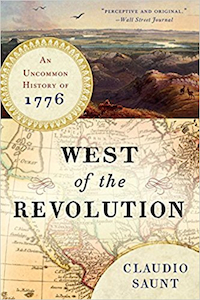

Of late American readers have been well served by a veritable cottage industry of works about the Roman Republic and Empire, and their respective falls, and various aspects thereof, and what lessons we, with our republic (or empire, as some would have it), purportedly at the precipice of analogous fiscal, ecological, military, social and/or political Seneca Cliffs, might learn from them. History may not repeat itself any more than we can wade into the same river twice, but, of course, we can step into rivers that look more than a sight familiar. Sometimes a nicely behaved river—let’s dub it the Goth Swan—turns of a sudden into a drowning horror. Indeed, a close reading of Roman history does suggest, in blurriest outlines, some analogies with contemporary trends and conundrums. But there are perhaps more valuable insights to be parsed from our own little-known and, relatively speaking, recent history.
In West of the Revolution, Claudio Saunt, a noted scholar of early American and Native American history, spotlights nine places and formative events of 1776 that rarely raise a blip on the radar of even the most well-educated Americans. As Saunt writes in his introduction, “The American Revolution so dominates our understanding of the continent’s early history that only four digits—1776—are enough to evoke images of periwigs, quill pens, and yellowing copies of the Declaration of Independence.”
>> CONTINUE READING AT WWW.CMMAYO.COM or Literal Magazine.

Working with a Working Library: Kuddelmuddel
Consider the Typewriter (Am I Kidding? No, I Am Not Kidding)
Visit my website for more about my books, articles, and podcasts.

